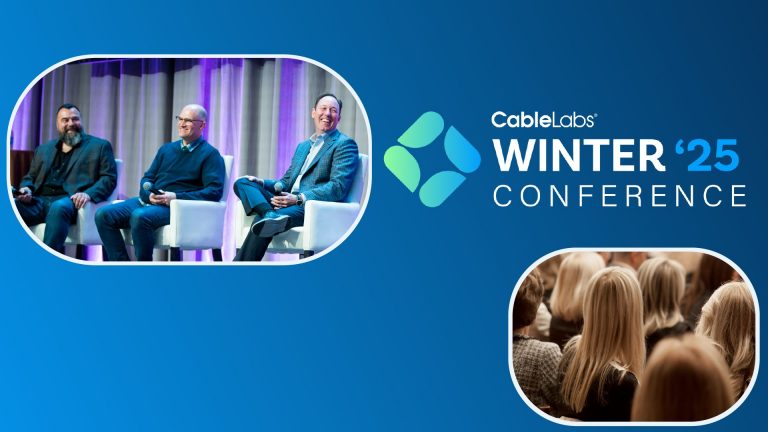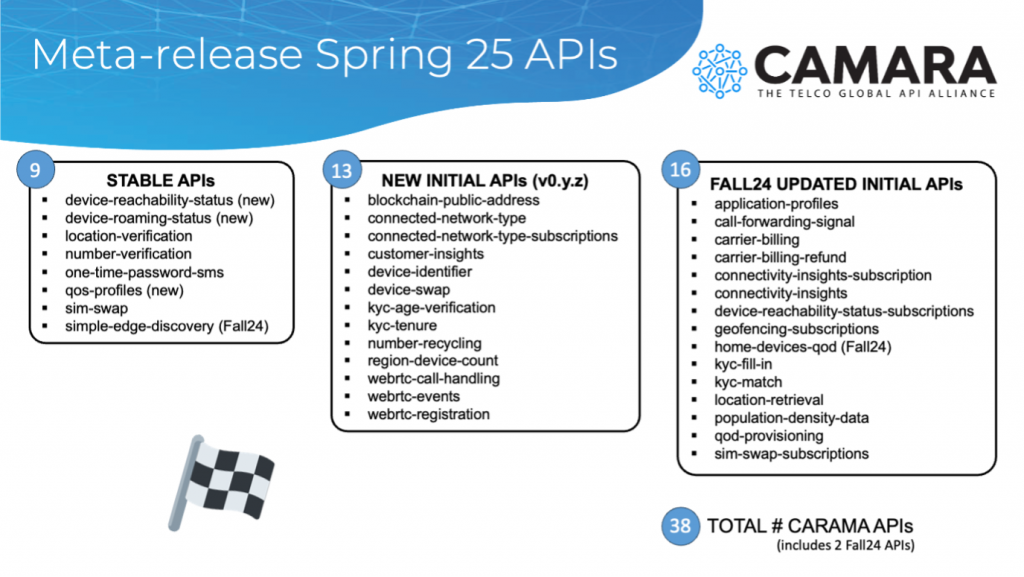Network as a Service
Open-Source Network APIs Advance With Latest CAMARA Meta-Release

Key Points
- A new release from the Linux Foundation’s CAMARA project includes 38 APIs, further helping bridge the gap between network operators and application developers.
- CableLabs contributions fall within our ongoing work to develop Network as a Service, a standardized solution for connecting applications to network services.
Last year, we shared how CableLabs is transforming networks through open-source API solutions as part of our work in the CAMARA project. Today, we’re excited to highlight the progress made in CAMARA’s newly published spring 2025 meta-release. The new release includes significant updates across CAMARA’s expanding suite of open network APIs — and spotlights CableLabs’ continued contributions to this global effort.
We actively contribute to the open-source project, which is hosted by Linux Foundation, to drive the development of new APIs and help advance industry alignment. These contributions are all part of CableLabs’ work on Network as a Service (NaaS), which allows network operators to expose previously unavailable features to application developers via open-source APIs. Other contributors to CAMARA include network operators — both wired and mobile — as well as application developers and hardware vendors.
Through this open-source approach, CAMARA aims to ultimately improve the performance of applications across all types of networks — a win for the entire industry.
What's New in CAMARA's Spring 2025 Meta-Release?
CAMARA’s spring 2025 meta-release marks a major milestone for the project, boasting 38 APIs — 9 stable APIs, plus 13 new and 16 updated APIs. The project continues to grow in momentum and industry adoption, bridging the gap between network operators and application developers through a common set of open APIs.
Here are some of the highlights from the Spring25 release that multiple service operators (MSOs) should have on their radar:
- Quality on Demand (QoD) with advanced quality of service (QoS) profile support, including Low Latency Low Loss Scalable Throughput (L4S)
- Continued enhancements to Edge Cloud, Connectivity Insights and Network Access Management APIs
- Creation of Session Insights sandbox API repository, which will enable real-time visibility into device behavior and network sessions from application to network operator. This was previously called Quality by Design and is now called Session Insights at CAMARA.
You can explore the full scope of the spring 2025 meta-release on the CAMARA wiki or read the Linux Foundation’s summary.
This spring release is the first of two planned for this year. After being released by CAMARA, APIs are available for anyone to download and use. The fall 2025 meta-release is currently in the planning phase.
Here’s a look at the timeline for the upcoming fall release:
- End of April: Scope finalized
- June: Code ready for testing
- July/August: Testing and defect fixing
- September: Official release targeted
Get Involved
Read more about the CAMARA open-source project on its website and join the project on GitHub. If you are a CableLabs member or part of our vendor community, you can join the Network as a Service working group. Member operators can also learn more by visiting our recently updated Member Portal, which requires a CableLabs account for log-in.
Let's help drive the industry forward together!
Technology Vision
How Broadband Service Innovation Can Change the Game for Operators

Key Points
- An integrated network environment will enable broadband operators to deliver seamless, higher-quality connectivity, ultimately enhancing customer experiences and service differentiation.
- Through collaboration with other industry stakeholders, operators can accelerate innovation and deploy new services more effectively, allowing them to stay ahead in a rapidly evolving broadband landscape while mitigating risk.
The future of connectivity will be built on networks that deliver seamless customer experiences. To differentiate themselves in the broadband market, operators must embrace relentless innovation and adaptive service models centered on network evolution, monetization strategies and enhanced user experiences.
As networks evolve beyond traditional boundaries, CableLabs’ ongoing commitment to network platform development, standards and specifications, and vendor interoperability provides a foundation for continuous service innovation.
The shift from infrastructure-centric competition to service-driven differentiation demands a new approach to service delivery. The convergence of fixed and mobile networks — and rapid advancements in satellite network technology — will empower operators to offer next-generation services.
Partnering for Progress in Next-Gen Connectivity
Key to advancing seamless connectivity services is collaborative innovation and problem-solving — a tenet of the Technology Vision for the future of the industry. By joining forces with others in the ecosystem, CableLabs, our member operators and the vendor community can align goals, bring together diverse perspectives, and accelerate the innovation and deployment of new services.
Below, we break down some of the areas of opportunity for differentiated services, what operators should consider now and how they — and other industry stakeholders — can engage with CableLabs in this work.
Fixed Network Evolution: Weighing the Benefits of PON
To meet growing demand for broadband, operators must ensure their networks can deliver higher capacity, lower latency and increased reliability. Passive optical networks (PONs) offer one strategic option to achieve these goals by:
- Extending fiber deeper into networks while maintaining cost efficiency.
- Enabling multi-gigabit speeds and supporting advanced applications to enhance service offerings.
- Providing a scalable foundation for emerging demands such as enterprise SD-WAN, Internet of Things (IoT) and AI-powered services.
Of course, DOCSIS-based HFC networks can also support many of these capabilities, but PON presents an alternative path that could align with some operators’ long-term strategies.
However, deciding when to transition to PON requires careful consideration. Here are three key indicators that may signal the right time to move forward:
- Capacity Constraints and Network Performance: If existing hybrid fiber coax (HFC) networks are approaching capacity limits, PON is one option that can provide the scalability needed to support data-heavy applications like cloud gaming and 8K streaming. When congestion and reliability issues impact quality of experience, operators should assess whether PON can improve performance.
- Long-Term Cost and Infrastructure Strategy: PON simplifies network architecture and supports higher-density service areas. In many cases, it may be a cost-effective long-term investment for operators looking to expand fiber deeper into their networks.
Operator Takeaway: Before switching to PON, operators should consider whether it could help them maximize investment returns and stay ahead of industry demands by aligning network evolution strategies with business objectives.
Advanced Optics: A Path Toward Coherent PON
Advanced optics play a critical role in ensuring that networks can deliver multi-gigabit speeds, support low-latency applications and optimize fiber deployments for both residential and enterprise customers. To meet growing demand, operators need fiber-optic solutions that can scale to meet increasing bandwidth and reliability requirements.
Investing in next-generation optical technologies allows operators to:
- Maximize fiber network efficiency by increasing capacity without requiring excessive infrastructure overhauls.
- Deliver higher-speed, lower-latency services to meet the needs of ultra-HD streaming, cloud gaming and AI-driven applications.
- Prepare for future speeds of 10G and beyond by leveraging advanced optical transport solutions that enable seamless scalability.
Designed for long-term scalability, Coherent PON (CPON) is one such solution. It allows for multi-gigabit symmetrical speeds while also reaching farther and splitting higher, and it improves on spectral efficiency relative to traditional PON technology. It is ideal for high-density areas, enterprise services and next-generation applications that require higher fiber capacity and lower latency.
Operator Takeaway: There is no one-size-fits-all approach to optical network evolution. Operators must assess their growth objectives, market conditions and infrastructure readiness to determine the best path for the future.
Fixed-Mobile Convergence: Leveraging the HFC Network
Fixed-mobile convergence (FMC) is emerging as a key strategy that allows operators to deliver a consistent connectivity experience across broadband, Wi-Fi, cellular and, in the future, satellite networks. As consumer demand for seamless, always-connected experiences grows, operators must find ways to integrate fixed and mobile networks to provide a more unified service.
By leveraging the HFC network for FMC, operators can:
- Reduce reliance on costly mobile spectrum by offloading mobile data to fixed networks where possible.
- Improve customer experience without service disruptions.
- Optimize network efficiency by dynamically routing traffic based on capacity and cost.
FMC allows operators to maximize their existing fixed network infrastructure while enhancing mobile service capabilities. Here’s how operators can take advantage of this shift:
- Wi-Fi Offload: Operators with extensive HFC deployments can offload mobile traffic to their Wi-Fi networks. This reduces cellular network congestion and improves performance by leveraging home and public Wi-Fi hotspots to supplement mobile coverage.
- Seamless Network Handoffs: With improved integration between fixed and mobile networks, as well as network intelligence, users can transition between fixed broadband and mobile networks without disruption. This is an important way to improve customer satisfaction in densely populated areas where mobile networks may experience congestion.
Operator Takeaway: Fixed-mobile convergence represents the next phase in network evolution, offering cost efficiencies, improved service reliability and a superior user experience. Operators who invest in HFC-driven FMC solutions will be well-positioned to compete in a world where customers expect continuous, high-quality connectivity across all their devices.
Security and Privacy: Leveraging Security as a Competitive Advantage
In today’s digital landscape, network security and data privacy are no longer just compliance requirements — they have become key differentiators that influence customer trust, retention and revenue growth. With cyber threats increasing in both sophistication and frequency, operators must move beyond reactive security measures and instead offer proactive, built-in security features that enhance service value.
Investing in advanced security and privacy solutions enables operators to:
- Differentiate their services by highlighting existing premium security features in networks that customers may not see from competitors.
- Reduce operational risks by preventing cyberattacks that could result in downtime, data breaches or regulatory action.
- Enhance customer trust and loyalty by providing robust protections for user data and privacy.
When security is viewed as a revenue driver rather than a cost center, operators can create value-added services by leveraging cutting-edge technology to protect network and customer data. Here’s how:
- In-Home Security: Enabling experiences in the home that are built upon a security foundation for device connectivity, making secure living easy and automated while providing peace of mind.
- Infrastructure and Operations Security: Implementing zero trust architectures ensures that network components don’t rely upon geography for security, but that every element is credentialed and authenticated. This creates challenges for adversarial lateral movement within the network and enhances security for both consumers and enterprises.
- Privacy-Enhancing Technologies: With increasing regulatory scrutiny on data privacy, operators can differentiate themselves by implementing confidentiality in communications — led by cable networks, through secure onboarding of devices and privacy-preserving practices pioneered by the cable industry.
Operator Takeaway: Security and privacy are no longer just back-end considerations. They are now frontline competitive advantages that impact customer decisions. Operators that proactively integrate zero trust security, privacy-enhancing technologies and intelligent threat detection into their service offerings will not only protect their networks but also gain a strategic edge in the market.
Next Steps for Investment in Service Innovation
Continuous service innovation is the heartbeat of the broadband industry. By investing strategically in network evolution, security and service integration, operators position themselves to capture new revenue opportunities and maintain market leadership.
The path forward for market differentiation begins with a careful assessment of where to invest and what to prioritize. If you’re an operator, here’s how to get started.
- Identify Market Gaps: Start by conducting thorough market research, including customer insights and competitor analysis. Using this analysis, identify unmet customer needs and competitive gaps to inform your technology investment strategy and service development roadmap.
- Leverage Industry Collaboration: Industry collaboration accelerates innovation while reducing individual risk. Participation in working groups and interoperability events helps operators share knowledge, validate solutions and ensure compatibility across vendor ecosystems while leveraging emerging technologies to differentiate.
- Adopt Emerging Technologies Strategically: Prioritize investments that align with long-term service objectives and focus on network upgrades that enable multiple service opportunities rather than single-use solutions.
- Measure ROI and Market Impact: Track key performance indicators such as customer response, technology performance and revenue indicators to measure implementation success. Adjust strategies and next steps based on market response.
Accelerating Service Differentiation Through Collaborative Innovation
While collaboration may seem counterintuitive as a differentiation method, working with other industry stakeholders is one of the best ways to develop scalable, real-world solutions that meet user needs. Industry collaboration drives standardization, accelerates technology adoption and reduces deployment risks. Without it, operator capabilities may be limited and could result in lost growth opportunities, poor user experiences and lagging innovation.
CableLabs remains committed to bringing the industry together by fostering collaboration among our member operators and the vendor community. Working groups, Interop·Labs events and other joint initiatives give operators a platform to help shape the networks of tomorrow by pooling resources, sharing best practices and developing interoperable solutions.
Our member operators can explore the newly updated member portal for details about our ongoing work and how to get involved in our projects, or learn more about working groups using the button below.
Strategy
The LEO Satellite Revolution: Five Considerations for Terrestrial CSPs

Key Points
- LEO broadband will continue to expand and play a central role in communications, ushering in a new era of “coopetition” between satellite operators and terrestrial communications service providers.
- CableLabs has just released a new members-only strategy brief analyzing and projecting Starlink’s capacity for broadband service, finding that the company could become a significant competitor in home broadband markets worldwide.
- Terrestrial home broadband operators should closely monitor the competitive threat from LEO broadband while also recognizing that the technology can complement terrestrial connectivity and play a key role in service innovation.
Connectivity is experiencing a revolution. Low Earth orbit (LEO) broadband has moved with lightning speed from a futuristic concept to reality, and it’s rapidly becoming a cornerstone of modern connectivity.
SpaceX's Starlink, the leader and only commercially operational player in this field, besides OneWeb, already serves almost 5 million subscribers in 117 countries. The company has provided critical emergency infrastructure during recent hurricanes and wildfires.
This rise of LEO broadband shows no signs of slowing down: Starlink is further pushing the envelope on network capacity as it prepares to deploy its latest V3 satellites on the new, much larger Starship rocket. V3’s supposedly twentyfold increased capacity would even enable gigabit services once sufficiently deployed. Provided Starlink’s claims of “breakeven cash flow” stand investors’ scrutiny, the company will also have the funds to further expand its constellation and service offering. Competitors such as Amazon's Project Kuiper and China's burgeoning LEO programs are hot on Starlink’s heels, and in the coming years could provide robust alternatives.
But what does this satellite internet boom mean for the terrestrial broadband industry? There’s no doubt that satellite will bring both opportunities and challenges, forcing operators like CableLabs’ member companies to ask some hard questions.
A new addition to CableLabs’ strategy brief series on LEO discusses how to analyze the technology’s capacity and examines scenarios for Starlink’s ramp-up. It is available exclusively for CableLabs member operators here.
Below, we provide a high-level look at five considerations for terrestrial broadband operators to keep in mind and also pose five questions for them to consider as the satellite broadband industry moves forward.
Competitive Threat
Starlink’s growing capacity will drive further rising broadband subscriber numbers. So far, most Starlink customers have no terrestrial alternative, so the company’s offer effectively expands the broadband market to remote areas. But once Starship deploys V3 at scale, there would be enough capacity for Starlink to become a significant competitor for home broadband subscribers everywhere.
Question 1: Where is cable market share vulnerable to LEO providers, and how far?
We examine this further in the new members-only strategy brief.
Truly Seamless Converged Low-Latency Connectivity
Starlink already has nine global mobile network operator (MNO) partners beginning to complement its terrestrial coverage with satellite-based connectivity. In the mid-term, this broadened coverage will provide “direct-to-cell” service to any reasonably up-to-date phone anywhere, making dead zones a thing of the past and ubiquitous connectivity table stakes. At the same time, optical free space communication between satellites will enable a major leap in reducing latency.
Question 2: How can broadband operators with a converged network vision integrate LEO as a complementary layer to enhance their service offerings?
“Coopetitive” Ecosystem Building and Coordination
It seems obvious that (at most) a few global LEO connectivity providers will prevail, and any communications service provider (CSP) wanting to offer seamless connectivity will have to partner. Any LEO satellite will be serving on its orbit as a “cell tower in the sky” for many operators in quick succession, and LEO players will simultaneously be competing with CSP’s core service offering.
Question 3: What are the best ecosystem and competitive strategies with LEO players in the mid and long-term? How can we coordinate spectrum use and allocation across borders?
Transactional Connectivity and Capacity Trading
Highly automated transactional trading will become a key mechanism to ensure that the emerging multi-layered ecosystems provide users with the right connectivity option at any time, using, for example, automated roaming and dynamic spectrum allocation.
Question 4: How can networks and users negotiate connectivity and capacity transactions effectively?
Edge Computing
LEO satellite constellations will effectively function as a new edge location with high computing capacity that is only one millisecond-hop away from any point on the planet. Already now, compute capacity on satellites handles complex image processing tasks. Amazon Kuiper has announced to integrate their offer with their AWS footprint. CableLabs’ Next-Gen Systems team is exploring the possibilities of this “Cloud in the Sky.”
Question 5: What use cases will this new satellite edge enable? How can it interplay with the evolving terrestrial edge footprint?
How CableLabs Can Help
This exciting time demands proactive engagement to stay ahead of the curve and chart a successful course towards sustained differentiation.
CableLabs experts have insights, tools and research at the ready to help our members deepen their understanding of the LEO broadband landscape, assess market risks and competitive threats, and drive innovation. Whether you’re a strategist, an engineer, a product manager or just someone fascinated by the LEO possibilities, the message is clear: Pay attention, engage with the experts and be ready to adapt. LEO broadband isn’t just on the rise — it’s redefining the horizon.
For more in-depth analysis, check out the new members-only strategy brief about LEO and subscribe to the CableLabs blog to stay tuned for future updates.
Wireless
Unlocking the Power of Seamless Connectivity

Key Points
- Seamless connectivity has become of paramount importance for operators that own hybrid network infrastructures and offer varied service offerings.
- CableLabs’ Seamless Connectivity working group is focused on validating and understanding the gravity of the problem by simulating real-world scenarios in a lab environment.
- The working group is now investigating solutions that could address the seamless connectivity issues. We showcased one potential solution, ATSSS, as a demo at last week’s CableLabs Winter Conference.
Seamless connectivity is increasingly becoming an integral part of the connectivity service offerings of multiple system operators (MSOs). MSOs with their hybrid network infrastructure and varied service offerings may supplement their connectivity offerings with other wireless operators — for example, mobile virtual network operator (MVNO) agreements with mobile network operators (MNOs) — in addition to leveraging their own infrastructure. Depending on the infrastructure they own, MSOs may have to contend with disparate sets of wireless infrastructures.
In such scenarios, the transition of the user’s data traffic between these disparate networks becomes critical for ensuring a consistent user experience. It is also key to enforcing uniform and personalized policies as users move in and out of coverage of these networks with regards to:
- The transition being optimally triggered, considering not just the received signal strength indicator (RSSI) but also the network congestion, availability of and interference from neighboring networks and the traffic requirements (based on traffic/application type).
- The transition being as quick and seamless as possible (without any noticeable service disruption to the user) while maintaining security and privacy of user data.
Addressing these challenges will enable seamless and consistent connectivity for subscribers, dynamically adapting to evolving user needs and network conditions.
CableLabs’ Work In the Seamless Connectivity Space
CableLabs recognizes the evolving mobile industry landscape driven by the introduction of 5G and the availability of new and innovative spectrum options. Aware of our members’ growing mobile subscriber base and a need to complement their existing broadband offerings, we understand how critical it is to resolve the pain points that they face today (or may face in the near future).
Considering this, CableLabs, in collaboration with our members, started a Seamless Connectivity working group (WG) to understand and validate some of these issues. The aim of the group is to come up with multiple solutions that could cater to specific member needs by aligning with their infrastructure and deployment strategies. Seamless connectivity is a key theme of the Technology Vision for the future of the industry.
One potential solution for addressing the seamless connectivity issue is ATSSS, or Access Traffic Steering, Switching and Splitting. To learn more about the standardized ATSSS feature, watch our demo video below. You can watch the full video, “Harnessing ATSSS: Seamless Traffic Switching for Uninterrupted Connectivity,” here.

To learn more, check out the paper on seamless connectivity that we published at SCTE TechExpo24.
If you have any questions on the ATSSS demo or seamless connectivity initiative or if you would like to participate in the working group and collaborate with us, please reach out to me or my colleagues Sanjay Patel, John Bahr and Neeharika Jesukumar.
DOCSIS
Event Advances Progress and Promise of DOCSIS Provisioning of XGS-PON

Key Points
- A recent CableLabs Interop·Labs event demonstrated ONU and config file interoperability across multiple OLT systems.
- The event made use of real-world DOCSIS config file concepts to provision a variety of residential services, including HSD, IP Voice and IP Video.
- It also exercised ONUs with varying numbers and types of Ethernet interfaces as well as devices containing an embedded gateway function.
At the recent DOCSIS® Provisioning of XGS-PON Interop·Labs event at CableLabs, suppliers of PON optical line terminals (OLTs) exercised their systems’ ability to configure XGS-PON optical network units (ONUs) via the use of DOCSIS-style configuration files. The event took place February 24–28 at our headquarters in Louisville, Colorado.
CableLabs member operators have long been familiar with the method of using a configuration file to provision services on a DOCSIS cable modem. Beginning a decade or so ago, DOCSIS-style configuration was also utilized by many operators to simplify the provisioning of IEEE EPON systems compliant to the DOCSIS Provisioning of EPON (DPoE) specifications. These DPoE virtual cable modem (vCM) config files enabled an operator to use the same service provisioning back-office systems that they originally deployed for DOCSIS cable modems to provision services on DPoE EPON networks.
Fast-forward to today, and many CableLabs member operators are deploying or preparing to deploy ITU-T-based PON technologies, including XGS-PON, 25GS-PON and 50G HSP.
Some XGS-PON OLT suppliers have now also adopted the vCM config file method for provisioning ONU services by adding a DOCSIS adaptation layer (DAL) software function to their system offering. The DAL solution performs the well-known cable modem DHCP and TFTP transactions on behalf of each ONU registering on each OLT managed by the system. The DAL parses the contents of each config file and translates those contents into directives on the OLT. This provides the OLT with the necessary details to complete the service configuration of a given ONU.
Using an OLT with a DAL capability isn’t the only method to configure services on each ONU. Other methods include the use of SDN-based procedures and protocols such as Netconf or OLT supplier-provided RESTful APIs. But the use of the DAL and DOCSIS-style config files can ease the transition of member operators into ITU-T-based PON technologies, without the need for wholesale replacement of the operator’s service provisioning back-office.
Supplier Participation in the Provisioning of XGS-PON Interop
We thank the supplier participants who helped make the February interop event so successful. The primary participants were XGS-PON OLT suppliers who showcased their DAL implementations.
These OLT suppliers included Calix, Harmonic and Nokia. In particular, Calix tested using their E7-2 OLT and DPx DAL. Harmonic brought their Pier OLT and cOS virtualized core software platform. And Nokia tested using their Lightspan MF-2 OLT with Altiplano controller and a DAL from their solution partner, ZCorum. As a bonus, Nokia demonstrated that the DOCSIS provisioning method can also be used to provision services on a 25GS-PON optical network unit (ONU).
In addition to the OLT supplier participants, MaxLinear was in attendance with their reference-design XGS-PON ONU, and TraceSpan participated with their NG-PON Xpert analyzer, whose DPoX Validation capability was instrumental for validating the correctness of the OMCI configurations that were set by the OLTs.
How the XGS-PON ONU Test Cases Unfolded
During the interop event, CableLabs provided an identical set of XGS-PON ONUs of various makes and models to each of the three OLT suppliers. CableLabs also provided a set of standard config files — one for each of the test cases defined in the interop test plan.
By utilizing a common set of ONUs and config files, we could see how each OLT-plus-DAL system reacted to a given config file on a given ONU. The overall goal of the event was to work towards a given ONU having an identical service configuration — for a given test case — across all the OLTs.
The test plan executed at this event was derived from the DOCSIS Provisioning of ITU-T PON tech report, which CableLabs published in December 2024. Test cases included basic HSD configuration of ONUs with a single Ethernet port as well as ONUs with multiple Ethernet ports. When configuring services on ONUs with multiple ports, a config file construct called a Cable Modem Interface Mask (CMIM) Classifier was utilized to control which ports on the ONU were active. Testing also included a triple-play (HSD, IP Voice and IP Video) test case, which utilized Differentiated Services Code Point (DSCP) traffic classifiers in the config file. A final test case that was executed from the interop test plan included the use of an ONU with an integrated eRouter functionality.
In cases where an OLT supplier was not initially able to successfully configure a given ONU for a given test case, we allowed the supplier to make customizations to the standard config file. This enabled the supplier to execute the test case and note where changes in their software might be needed to successfully use the standard config file in the future.
Each test case executed during the event made use of the lab’s 100GE traffic generation system, the lab’s standard DHCP and TFTP server infrastructure, and a PON analyzer to decode the ITU-T-specified ONU Management and Control Interface (OMCI) message exchanges across the PON. Many thanks to Charter Communications and TraceSpan Communications for supplying additional NG-PON Xpert analyzer units, enabling each OLT supplier test setup to utilize a dedicated analyzer.
Beyond the primary DOCSIS provisioning focus of this February event, we were pleasantly surprised that one of the supplier participants in this event brought OLT and ONU software versions that demonstrated partial compliance to the Cable OpenOMCI I01 specification. We look forward to seeing many more suppliers follow suit in the near future.
Applying the Lessons Learned
Overall, the results of the event were encouraging, with both established as well as new supplier entries into this product space showcasing their abilities to provide common service configurations across a wide variety of ONU makes and models.
The implementations exercised at this event indicate that these suppliers believe that a DOCSIS Provisioning of XGS-PON solution will be an important part of their product portfolio for the foreseeable future. We plan to take the lessons learned from this event and apply them to a future update of the DOCSIS Provisioning of ITU-T PON tech report.
Join the Next PON Interop
CableLabs is planning three more PON Interop·Labs events to be held in our Louisville, Colorado, labs in 2025. Our next event is scheduled for the week of April 28, 2025.
The April event will provide an opportunity for OLT suppliers to return with their DAL solutions to once again test ONU and config file interoperability. In addition, ONU and OLT suppliers with software implementations compliant to the Cable OpenOMCI I01 specification will be invited to exercise the capabilities defined in that specification.
Fiber
How We’re Navigating the XGS-PON Interoperability Landscape

Key Points
- Broadband operators are increasingly integrating fiber to the premises into their service portfolios, embracing passive optical network (PON) technology for their fiber-based access networks.
- To optimize PON integration into networks, CableLabs hosts interoperability events to help ensure compatibility between vendor equipment.
There has been momentum in the broadband industry to provide fiber to the premises (FTTP) solutions as a part of an operator’s service portfolio. While optical technologies have long been a part of the cable network, FTTP is the chosen architecture for all-fiber access networks.
For FTTP, the premises can be a subscriber’s home, a commercial location, a campus environment, a multi-dwelling unit (MDU) or another location. Over the past couple of decades, operators have embraced the passive optical network (PON) technology for their fiber-based access network implementations. The point-to-multipoint topology of PON lends itself nicely to the current and future designs of the broadband network.
More recently, many operators have begun deploying PON technologies defined by the International Telecommunications Union Telecommunications Standardization (ITU-T). As a part of its standards development, ITU-T has released standards for 10 Gigabit Symmetrical PON (XGS-PON).
With broadband operators beginning to deploy multiple gigabit service, there’s a growing current of enthusiasm and interest for the efficient deployment, management and maintenance of those access networks. Furthermore, the speed at which technology is moving is impressive and expensive. It is challenging to keep pace with these advancements, which require a matrix of expertise and decision-making support.
Building on PON’s Momentum
PON is one of the technologies that keeps marching forward. CableLabs has participated in the development of PON-based standards and specifications for over a decade, and we’re continuing in that vein to help operators lower barriers for deploying and operating FTTP solutions.
Common provisioning and management of PON in the broadband industry typically requires support of legacy systems that have been in place for decades, e.g., DOCSIS® operations support system (OSS) or integration with newer back-office systems. Near-term objectives for the work CableLabs is beginning include XGS-PON and 25GS-PON support, covering applicability for next-gen PON flavors with special focus on vendor neutrality through device interoperability.
CableLabs has created two working groups dedicated to optimizing the integration of ITU-T PON technologies into cable networks. The two working groups are the Common Provisioning and Management of PON (CPMP) and Optical Operations and Maintenance (OOM). These two groups are complementary in their activities. The CPMP group is focused on supporting the back-office provisioning and management of XGS-PON as well as the interoperability of optical network units (ONUs) with optical line terminals (OLTs). The OOM working group is focused on the operations and maintenance of the underlying optical networks.
Hurdles in Interoperability
There are always tradeoffs with technology, whether it’s price, timing or things out of an operator’s control, such as product availability. However, when customer premises equipment (CPE) is required, there is always an underlying benefit to the interoperability of that device with the network that it connects to.
Interoperability provides necessary competition, which results in pricing benefits, innovation and choice for operators. Having the choice of which ONU is connected to the OLT is instrumental in providing lower cost services with the ability to help foster innovation.
Interoperability involves several technical and logistical challenges. Addressing these hurdles typically involves a combination of adherence to standards, thorough testing and collaboration between vendors to ensure equipment from different manufacturers can work together seamlessly. These hurdles to interoperability include:
- Standardized technology: Standards are not necessarily the end-all-be-all for successful interoperability. In the context of XGS-PON, there is the ONU Management and Configuration Interface (OMCI). This OMCI information is defined in the ITU-T G.988 standard. This is the accepted way to configure and manage ONU equipment via the OLT. OMCI is extremely comprehensive and as such, it is very difficult to provide simple and extensible ways to support interoperability.
- Vendor-specific implementations: Vendors may support proprietary features or extensions in their products. While these can offer enhanced performance, additional functionality and vendor differentiation, they can also create interoperability issues if these features are not supported universally across different vendor equipment.
- Operator requirements: Each operator deployment is different, and each operator requires a specific implementation to support their business objectives. While certain configuration parameters, fault reporting and performance monitoring are common among different implementations, there are always variations, and this requires different configurations for network components and CPE.
- Network configuration, service activation, and management: XGS-PON networks require precise network management and configuration to ensure proper operation. Differences in management systems and configuration approaches between vendors can create integration challenges.
- Testing and certification: Comprehensive testing is required to ensure that equipment from different vendors works together as expected. Many operators and vendors don’t have the infrastructure to support such testing, which becomes a barrier when choosing equipment suppliers. A significant impact on time-to-market is testing. Testing and validation of requirements is a significant cost and effort.
Mitigating Interoperability Hurdles
CableLabs, with the support from vendor partners and member operators, has long had a successful formula for developing specifications that have transferred to CPE interoperability. Device interoperability is the primary objective when producing interface specifications between network components. Vendor neutrality through that device interoperability is a key intention for operators deploying XGS-PON in cable networks.
Developing documentation to standardize technology with the intent for interoperability is a fine line to walk when working with multiple operators and equipment manufacturers. To add fuel to the fire, when standards have already been written, developing a method for interoperability can require modifications to the original formula. By leveraging the existing G.988 OMCI standard, CableLabs is developing a Cable OpenOMCI specification to support ONU configuration in an interoperable way within the industry.
While it is always a goal to develop common processes and requirements that encourage the vendor ecosystem, sometimes vendor-specific parameters are required to support vendor differentiation. It’s important for vendors to differentiate their products, which provides their teams to innovate. The work CableLabs is doing to support device interoperability includes the ability for vendor-specific configurations when needed.
Each operator is different, and each operator has its own set of business objectives that translates to the products it buys, the services it offers, and the networks it builds. When developing specifications to support a myriad of operator requirements that span the globe, we must always be cognizant on ways to support those requirements. During our specification development we work together to identify and accommodate those differences needs across the industry.
While each network is different, for interoperability, some network configuration, service activation, and management must be standardized. This can be required anywhere in the network from the back office all the way to the end of the network with CPE. When building a program to support interoperability this entire ecosystem is in play. The coordination effort and the development of a common set of processes to support interoperability with device configuration, service activation and management is key.
In February, we hosted a DOCSIS® Provisioning of XGS-PON Interop·Labs event for members of the CPMP working group. Testing and certifying devices are very important for interoperability. To help remove the barriers of cost and reduce time-to market with comprehensive testing, CableLabs provides formal interoperability events like this as well as ongoing interoperability activities. Additionally, if needed, CableLabs will develop a certification program to test and certify ONUs against the specification.
Pushing Toward XGS-PON Adoption
While XGS-PON is gaining interest with cable operators, the industry is keen to develop procedures and specifications to support ONU interoperability with OLTs. While there are always common hurdles to interoperability, they are never enough to stop interoperability. Since the XGS-PON technology has already been defined and standardized by ITU-T, this does bring a different hurdle to the work.
Typically, CableLabs and its vendor partners and member operators develop the specifications that support interoperability. However, in this instance, we must leverage existing standards from another SDO. It won’t be impossible, but it will be a heavy lift.
Learn more about our working groups and how CableLabs members and our vendor community can help us chart the way forward for technologies like this.
AI
Empowering Field Operations with Agentic AI

Key Points
- Agentic AI is structured around groups of specialized agents that serve as subject matter experts in their own areas of expertise, capable of addressing field operations tasks using structured decision-making.
- The intelligent, autonomous multi-agent system allows operators to integrate predictive analytics into field operations, lowering their costs, minimizing service disruptions and enhancing the customer experience.
Field operations teams are essential for ensuring the seamless performance of modern networks, including hybrid fiber coax (HFC), fiber and mobile infrastructures. However, as networks grow in complexity, traditional troubleshooting methods — manual workflows, static documentation and reliance on expert technicians — struggle to keep pace.
Enter Agentic AI, a transformative approach that embeds intelligent, autonomous AI-driven agents into field operations. These agents act as subject matter experts (SMEs), each specializing in a specific aspect of network troubleshooting, decision support and workflow optimization. By leveraging this structured, multi-agent AI system, organizations can scale expertise, reduce resolution time and enhance operational efficiency.
The Evolution of AI in Field Operations
From AI Assistants to Structured Agentic AI
While AI-powered virtual assistants have been used to support technicians with knowledge retrieval, they lack structured decision-making capabilities. Agentic AI introduces a multi-agent system where each AI agent specializes in a distinct area of expertise, much like human SMEs within an organization.
These specialist AI agents are grouped together into teams based on their expertise, allowing groups of specialist AI agents to collaboratively solve problems in a shared area of expertise, like human teams within an organization. This multi-agent team approach allows for efficient and accurate decision-making to address field operations tasks.
How Agentic AI Operates as a Team of SMEs
Agentic AI is structured around multiple specialized agents, each performing specific roles within the troubleshooting and network maintenance process. These agents collaborate dynamically, ensuring that every decision is informed by real-time data and domain knowledge.
Key AI agents include:
- Knowledge Retrieval Agent (SME in Network Standards & Best Practices)
- Retrieves industry standards, vendor documentation and best practice guides.
- Cross-references sources such as CableLabs specifications and SCTE standards.
- Telemetry Analysis Agent (SME in Real-Time Network Monitoring)
- Continuously monitors network logs, telemetry data, meter measurements and service degradation patterns.
- Detects anomalies like signal degradation, upstream noise or fiber attenuation.
- Troubleshooting Workflow Agent (SME in Guided Resolutions)
- Generates step-by-step troubleshooting workflows based on real-time conditions.
- Adapts workflows dynamically based on technician feedback and sensor inputs.
- Decision Support Agent (SME in Root Cause Analysis & AI-Driven Recommendations)
- Synthesizes insights from multiple agents to determine the most effective resolution.
- Suggests alternative troubleshooting paths if the initial fix does not resolve the issue.
- Proactive Network Maintenance Agent (SME in Proactive Network Health & Failure Prevention)
- Uses historical patterns and AI-driven models to detect potential failures before they occur.
- Recommends preemptive maintenance to avoid service disruptions.
These agents are combined into agentic teams that are tailored to different areas of expertise, such as impairment types, enabling targeted collaboration and troubleshooting. By structuring AI in this multi-agent, SME-like framework, Agentic AI mirrors the way expert teams collaborate in real-world field operations, ensuring that each aspect of troubleshooting and maintenance is handled with precision.
Agentic AI in Action: Enhancing Field Operations
AI-Driven Troubleshooting for Faster Resolution
With Agentic AI, network troubleshooting shifts from manual trial-and-error approaches to data-driven, AI-guided processes. When a technician encounters an issue, the AI agents work together to provide precise, real-time recommendations.
Example: Resolving Signal Impairments in HFC Networks
- The Telemetry Analysis Agent detects signal impairments from network telemetry.
- The Knowledge Retrieval Agent pulls relevant troubleshooting workflows from specs, standards and vendor manuals.
- The Troubleshooting Workflow Agent generates a guided resolution process, suggesting tests with field meters.
- The Decision Support Agent analyzes technician input and network readings, refining recommendations dynamically.
- If the issue is a recurring fault, the Proactive Maintenance Agent flags it for proactive intervention.
This real-time, multi-agent collaboration ensures that field technicians receive expert-level guidance instantly, reducing mean time to resolution (MTTR) and improving service quality.
Scaling Expertise with AI-Driven SMEs
Transforming Field Training & Knowledge Retention
A major challenge in field operations is scaling knowledge across teams. Traditionally, new technicians rely on classroom training and shadowing experienced engineers. With Agentic AI, expertise is available on demand — every technician, regardless of experience level, can access AI-powered SMEs for troubleshooting guidance.
Key Benefits:
- Faster onboarding: New hires gain instant access to SME-level knowledge, reducing training time.
- Standardized troubleshooting: AI ensures consistent best practices across teams based on SCTE Learning and Development guidelines.
- Knowledge retention: AI continuously learns from past cases, preserving institutional expertise.
By deploying Agentic AI as a structured knowledge system, organizations can scale expertise at unprecedented levels.
Beyond Troubleshooting: AI-Powered Proactive Maintenance
Future Work: Predicting & Preventing Failures Before They Occur
Instead of reacting to service disruptions, Agentic AI enables a shift toward proactive and predictive network maintenance.
- The Predictive Maintenance Agent continuously analyzes historical network performance trends.
- AI identifies early warning signs of network failures, such as cable degradation, fiber attenuation, or RF noise issues.
- The system recommends preemptive maintenance actions, reducing truck rolls and service downtime.
By integrating predictive analytics into field operations, network operators can lower costs, minimize disruptions and improve customer experience.
DOCSIS
Interop Puts DOCSIS 4.0 Technology’s Speed and Stability Front and Center

Key Points
- The first DOCSIS® 4.0 Interop·Labs event of 2025 focused on speed and stability, providing another opportunity to test interoperability scenarios between products leveraging DOCSIS 4.0 technology.
- If you are attending CableLabs Winter Conference, join us for “The What, Why and How of Future HFC Solutions” to explore the potential of future generations of DOCSIS networks.
As the world of broadband connectivity evolves, so does the technology that powers it. The evolution of DOCSIS technology has been a cornerstone of high-speed internet delivery, enabling service providers to meet the growing demands for faster and more reliable internet access. DOCSIS 4.0 technology represents the latest milestone in this journey, offering impressive speeds and new capabilities.
The latest Interop·Labs event, which took place Feb. 10–13 at CableLabs in Louisville, Colorado, showcased these capabilities and more, focusing on speed and stability — crucial factors in determining the quality and reliability of an internet connection.
A Bright Future for DOCSIS 4.0 Technology
DOCSIS 4.0 technology is poised to revolutionize broadband connectivity, offering significantly faster speeds, better efficiency and enhanced security. Its backward compatibility with existing DOCSIS 3.0/3.1 infrastructure makes it a flexible solution for both service providers and consumers.
As with any major technological leap, ensuring smooth interoperability between old and new systems is key to a successful transition. By offering a scalable, future-proof solution that can be deployed gradually, DOCSIS 4.0 technology allows operators to gracefully migrate to these new products.
Why Speed and Stability Are Critical
Speed refers to how quickly data is downloaded or uploaded, often measured in megabits per second (Mbps), and plays a key role in activities such as streaming, gaming and video conferencing. Stability, on the other hand, is about the consistency of that connection.
A stable connection ensures that users experience minimal interruptions or slowdowns, even during peak usage times. Both high speed and stable performance are essential for seamless online experiences, especially in households or businesses that rely on multiple devices or heavy internet usage.
Key Contributors and Participants
The DOCSIS 4.0 specifications describe both frequency division duplex (FDD) and full duplex (FDX) modes of operation. For this interop, the first of 2025, new modems and RPDs that supported both modes (on the same device) were participants for the first time.
Attendance at the interop was high and included new suppliers and products, as well as two operators that joined to observe demonstrations, interact with the suppliers and discuss their own DOCSIS 4.0 network progress.
Suppliers included CommScope and Harmonic, who brought DOCSIS 4.0 CCAP cores to the event. For the first time, we saw new Remote PHY Device (RPD) platforms from three separate suppliers: Harmonic, Teleste and Vecima. Seven DOCSIS 4.0 modem suppliers — Arcadyan, Askey, Gemtek, Hitron, Sagemcom, Sercomm and Ubee — brought multiple cable modem models. Calian participated with its test solutions, and Microchip participated with its clock and timing system.
Broadcom has developed new chipsets that enable a device to operate in either FDD or FDX mode, under the control of the network. Another chipset supplier, MaxLinear, was also in attendance, exhibiting its latest DOCSIS 4.0 modem innovations.
Testing scenarios involved using a virtual core from one supplier, and RPDs and DOCSIS 4.0 cable modems from various other suppliers. The products were mixed and matched to verify interoperability scenarios and speeds through the system. As before, DOCSIS 3.1 and DOCSIS 4.0 devices were combined to demonstrate the cross-compatibility of existing and new technology. Suppliers providing test equipment used these setups to verify their solutions.
Broadband Service Enhancement
The February interop was another opportunity to drive interoperability between some of these new products/platforms and some existing ones, ensuring that the different systems and devices would seamlessly work together to exchange information. Interoperability is vital to enabling these devices to connect and interact. By fostering interoperability, the DOCSIS ecosystem continues to provide innovation and solutions to enhance broadband services, ultimately leading to better outcomes for consumers.
Remote PHY Interoperability
Although modems were the focus, the event also looked at the interoperability between DOCSIS 4.0 cores and RPDs. We branched into more and different configurations, moving beyond one-size-fits-all configurations. These products are going to be deployed in many scenarios, and going deeper into these various configurations will ensure flexibility as DOCSIS 4.0 technology moves into the field.
Join Us Soon
The next DOCSIS 4.0 interop is planned for the week of March 31 at CableLabs.
If you are a member or vendor attending CableLabs Winter Conference, join us for our two-part session “The What, Why and How of Future HFC Solutions.” We’ll explore the potential of future generations of DOCSIS networks, exploring how the evolution of the technology will support tomorrow’s hybrid fiber coax networks. This two-part session begins at 12:45 Tuesday, March 11.
With DOCSIS 4.0 technology, the future of broadband looks brighter, faster and more connected than ever before. The technology’s seamless integration into current systems ensures that consumers will continue to benefit from fast, reliable internet — no matter where they are on their broadband journey.
Wireless
L4S in Wi-Fi: A Path to Seamless Interactive Experiences

Key Points
- Broadband service providers are beginning to implement L4S functionality in their networks. The technology enables applications to achieve low latency and high efficiency, ultimately helping deliver enhanced and more reliable user experiences.
- CableLabs worked with the Wireless Broadband Alliance to develop a set of guidelines for equipment suppliers to use when implementing L4S in their Wi-Fi products.
- Wi-Fi networks are frequently a point of congestion in end-to-end networks, creating a need for L4S support in those networks.
Modern networks deliver impressive speeds — often reaching gigabits per second — yet they still suffer from unpredictable delays that can disrupt interactive applications. Whether it’s video conferencing, cloud gaming or remote collaboration, these inconsistencies can lead to frustrating user experiences. As network operators strive to enhance reliability and responsiveness, a more effective solution is needed.
To address this need, the Internet Engineering Task Force (IETF) — an organization responsible for developing open internet standards — has specified the Low Latency, Low Loss and Scalable (L4S) throughput architecture. L4S enables applications to implement a new mechanism to ensure that they are sending their data as fast as the network can support, but no faster. The result is efficient capacity usage with minimal queuing delay and low packet loss.
This shift to a more comprehensive quality of service (QoS) model is essential for delivering smooth and uninterrupted performance across a wide range of services, from gaming and video streaming to cloud computing and augmented reality.
What Is L4S?
The power of L4S stems from new congestion control algorithms that adapt to new fine-grain notifications of congestion at the IP layer across various network elements along an end-to-end (E2E) path. While L4S can be deployed on each element of the network, its most significant impact is at points of congestion, also referred to as network bottlenecks — where the rate of incoming packets can exceed the departure rate.
The cable industry already adopted support for L4S, as part of the Low Latency DOCSIS® 3.1 specifications (and it carries forward into DOCSIS 4.0 gear as well). Operators are beginning to enable this functionality in their networks, and more are expected to do so over the coming months. That said, the broadband access network segment is only one potential bottleneck. There are others on the E2E path.
The Need for L4S in Wi-Fi Networks
Wi-Fi networks, in particular, require L4S support as they are frequently a point of congestion in E2E networks. Indeed, although Wi-Fi networks often advertise their maximum capacity that is greater than the broadband access connection, actual performance is significantly influenced by factors such as the distance between clients and the access point (AP), as well as the number of APs and clients operating on the same channel. This need for L4S support is even more critical given that a substantial portion of internet traffic is transmitted over Wi-Fi.
WBA L4S Implementation Guidelines and NS3 Simulator
Wi-Fi presents unique challenges for L4S implementation compared to wired technologies such as DOCSIS® networks. While wired networks primarily see only buffering delays, Wi-Fi additionally introduces media access delays, which can be significant in congested environments. To tackle these challenges, CableLabs worked within the End-to-End QoS Working Group of the Wireless Broadband Alliance (WBA) to produce a set of guidelines to implement L4S in current Wi-Fi products.
The guidelines cover:
- An overview of L4S technology, explaining its mechanics and benefits.
- The importance of L4S support in Wi-Fi equipment for improving E2E application performance.
- Implementation strategies for Wi-Fi equipment suppliers to enable L4S functionality in their products.
- Simulation and test results demonstrating the advantages of L4S in real-world scenarios
The simulation results are based on a Wi-Fi NS3 model developed by CableLabs, designed to evaluate L4S performance in Wi-Fi networks. The model is open-source and available to industry and research players to support L4S deployment and assess its impact on various use cases. In addition, CableLabs provided field test data that were conducted with a Nokia AP.
The Future of L4S in Wi-Fi
Wi-Fi equipment suppliers today can leverage the L4S Implementation Guidelines to develop support on their existing platforms (e.g. Wi-Fi 7 devices). Several proposals from industry leaders, including CableLabs, aim to incorporate L4S support into the 802.11 Wi-Fi standard, ensuring native support for L4S across future Wi-Fi generations.
In addition, as the ecosystem matures, CableLabs will continue refining the NS3 model to expand its applicability to more scenarios and use cases. This ongoing effort is being advanced in collaboration with the WBA E2E QoS working group.
L4S is a critically important next step in the evolution of the internet that solves many of the issues that cause frustrations today, where it seems that bandwidth alone hasn’t fully enabled reliable and responsive interactive application experiences.
To fully take that step, the segments of the network that are the likely bottlenecks in residential deployments — the access network and the Wi-Fi segment — both need built-in support for L4S.
Events
Last Chance! Shape the Future of Connectivity at Winter Conference

Key Points
- Registration closes Monday, Feb. 24, for CableLabs members to attend Winter Conference 2025 in Orlando, Florida.
- Register today to join us at this exclusive gathering for our member and exhibiting vendor communities to network, collaborate and strategize on the future of the broadband industry.
- Highlights include AI futurist Zack Kass, our keynote speaker, and high-impact sessions covering Network Evolution, Security Evolution, Differentiated Services and AI.
Are you ready to strategize and share at CableLabs Winter Conference 2025? In just a few weeks, an exclusive gathering of CableLabs member operators, approved vendors and industry thought leaders will meet in Orlando, Florida, to discuss and collaborate on how to move the industry forward.
Join us March 10–13 as we work to unlock the value of seamless connectivity and capitalize on the opportunities ahead. Member registration closes Monday, February 24. Secure your spot to take part in charting a course for success in the next era of connectivity.
The Path Ahead
Winter Conference sessions will be an in-depth exploration of the Technology Vision, with each session highlighting individual aspects of the framework — the architectures, protocols, technologies and strategies required for building and evolving the network of the future together. Hear from the experts on topics such as Network Evolution, Security Evolution, Differentiated Services and AI and take home practical insights to inform and inspire your own journey.
By aligning on a shared vision and working together to foster more robust, efficient and sustainable industry ecosystems, our member operators and the vendor community can collaboratively unlock new levels of agility and create solutions at scale. The Technology Vision, developed in collaboration with our members, lays out a roadmap for this more connected, intelligent and secure tomorrow.
Key Winter Conference Highlights
Register today to join us for high-impact sessions, plus hours of additional networking and vendor connections during provided meals and Exhibit Floor receptions. Members-only project meetings will be held Thursday, March 13.
Highlights this year for members and exhibiting vendors include Zack Kass, our keynote speaker. The AI futurist and former head of go-to-market at OpenAI will share his vision for a future powered by AI, offering actionable strategies for leveraging technology to accelerate innovation. Also, new this year, discover how four global startups are disrupting connectivity, focusing on solutions to enhance network performance and reduce latency during our neXus: Startup and Scaleup Spotlight.
View the full agenda for more details. All sessions and demos at a glance:
Tuesday, March 11
Sessions
- Shedding Light on Tomorrow’s Optical Access Networks
- The Rise of AI Automation: A Catalyst for Network Innovation
- Broadband Lunch: Insights Into Forecasting Network Demand
- The What, Why and How of Future HFC Solutions (two parts)
- Shaping the Security Evolution: Strategies from Industry CISOs
- The Power of NaaS: Simplifying Connectivity With Zero Touch Onboarding
- The Next Generation of Wi-Fi Access: Transforming the Connected Home and Beyond
- Breaking Barriers: Buildling Scalable Telemetry for Multi-Access Network Innovation
Demonstrations
- Mobile Wi-Fi Steering to Cellular
- Spectrum Monitoring
- Adversarial Machine Learning and Machine Augmented Penetration Testing
- neXus: Startup and Scaleup Spotlight: Redefining the Connected Home Experience
- neXus: Startup and Scaleup Spotlight: Making Wi-Fi Smarter Through AI-Powered Spectrum Slicing
- NaaS Featuring Traveler Wi-Fi
Wednesday, March 12
Sessions
- What Lies Ahead: Shaping the Future of Connectivity
- Spectrum Policy: Opening a New World of Connectivity Options
- API-First Networks: Building the Foundation for Future Services
- Redefining the Road to Reliability
- Security Evolution: Threats, Technology and Product Differentiation
- A Coherent Path to FTTP Deployments
- The Quest for Seamless Connectivity
- Context Is King: Unlocking Differentiated Services With Smart Networks
- Balancing Economic Trade-Offs in the Last Mile
Demonstrations
- neXus: Startup and Scaleup Spotlight — Unlocking the True Potential of Advanced Networks
- neXus: Startup and Scaleup Spotlight — Revolutionizing Network Operations with Agentic AI
- Harnessing ATSSS: Seamless Traffic Switching for Uninterrupted Connectivity
- Mobile Wi-Fi Steering to Cellular
- Spectrum Monitoring
- Adversarial Machine Learning and Machine Augmented Penetration Testing
Smaller Market Conference
Ahead of Winter Conference, we invite small and mid-tier multi-system operators to join the Smaller Marketing Conference on Monday, March 10, to discuss the issues that are most important to them and their teams. This event is available for CableLabs members and NCTA guests. Registration for Smaller Market Conference is separate from Winter Conference, so if you are planning to attend, please be sure to register for both.
Make Your Mark at CableLabs Winter Conference
Are you ready to impact the future? Join us at Winter Conference 2025, and be part of the conversation on guiding the industry’s path forward. Beyond simply being an opportunity to
Attendees will not only learn more about the Technology Vision. They will also take part in important conversations that will shape the direction and influence the success of that strategic vision.
Registration for Winter Conference 2025 is open for members through Monday, Feb. 24. Secure your spot today.


